Category Archives: Benfieldside
The Other Benfieldside
To date, the images and details I have shown on Benfieldside have related to the main and original station. However, there is more!
Benfieldside’s original builder, John Wright, constructed a significant extension a few years after completing the core layout. This was shown at the time in the Model Railway Journal (issue 57, 1992) and has not really be seen since.
When John’s interests moved on, he disposed of both parts of the layout and in turn the new owner decided he did not wish to retain the whole. However, he elected to retain the extension in order to convert it to P4 as his home layout (Benfieldside was all constructed as an EM layout). We all know what life is like – jobs, family life and other priorities get in the way but progress is now being made. The two main lines are now operational, as these two videos show.
The new layout will be NER as a core, but with also a Midland presence. It appears that the Midland has provided the motive power for the test train!
As you can see, Benfieldside’s extension was centred around a substantial viaduct with a degree of siding to one end. Its owner is proposing to make a small MPD here, the beginnings of which are visible in the videos.
There is still a way to go both in the adjustments around the MPD but also in refreshing the scenery. But never the less, as you can see it is another impressive layout.
The Other Auto-coach
Some time back I posted about the construction of a NER autocoach that I was building for Benfieldside and subsequently what it looked like once painted by Warren Heywood.
The NER generally used these in pairs, with a loco sandwiched between, although they did go out singly and even as quads. In this case, the Benfieldside team wish to operate them as a pair, as the bay to the right of the layout is conceived to receive such a train, with a NER / LNER G6 in between. This means that there was pressure to build the second from the moment I handed the first over. They have recently given me a favour, so it was high time I repaid it.
It is now completed down to the final check over stage (which has indicated that I need to put the steam heating pipes on – doh!) and then it can be delivered. So I have braved the fading light this afternoon (so sorry about some of the depth of field issues) to take a few pictures and to prove to the fellas it is done!
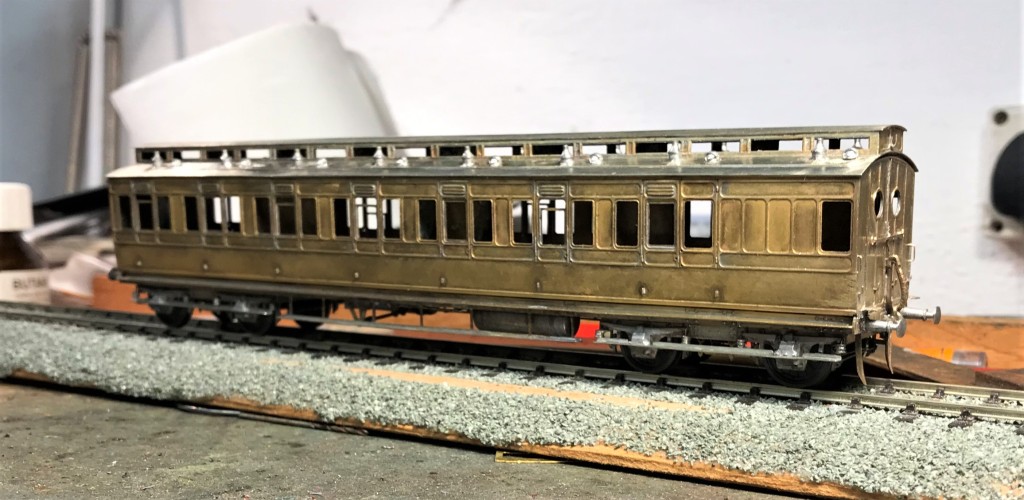
I completed a few personal upgrades to the kit in both this and the earlier autocoach. Chief of these is around the roof where I ditched the plastic roof and replaced it with rolled brass. This was formed of 0.25mm to give it a tangible depth, which makes its rolling a fair challenge. Add to this, I elected to cut out the portion below the clerestory, so that it was a clerestory! By the time I had added the gas lines and the various gas lamps and ventilators, I reckon there is around 20 hours in making the roof alone!
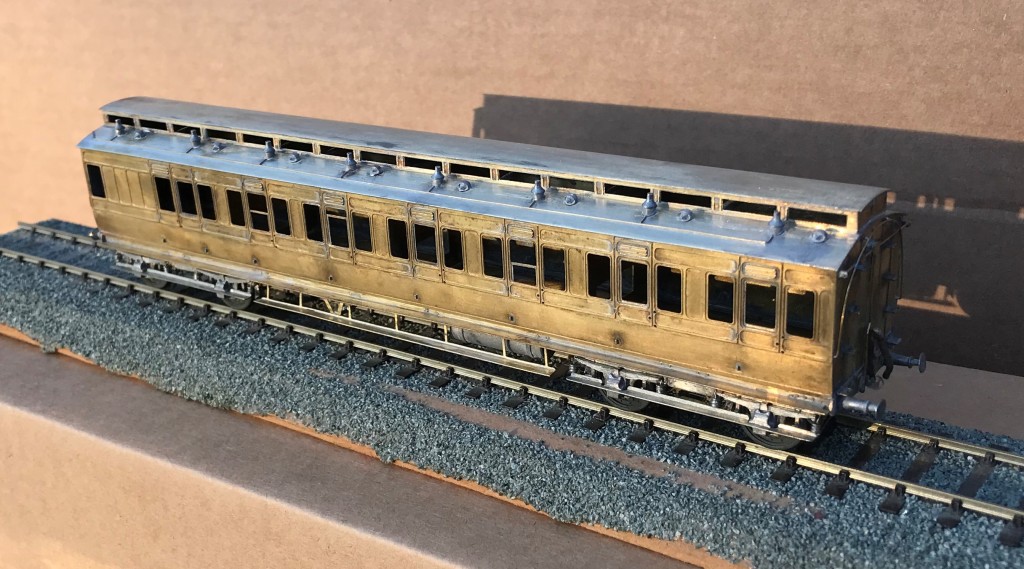
The prototype coaches were fairly long lived and numerous. They thus collected a good number of alterations and differences over time. I took some guidance to David Addyman and tweaked the kit in respect of gas lines, foot steps, handrails, footboards and gas cylinders. If someone thinks this is wrong, please don’t tell me!!
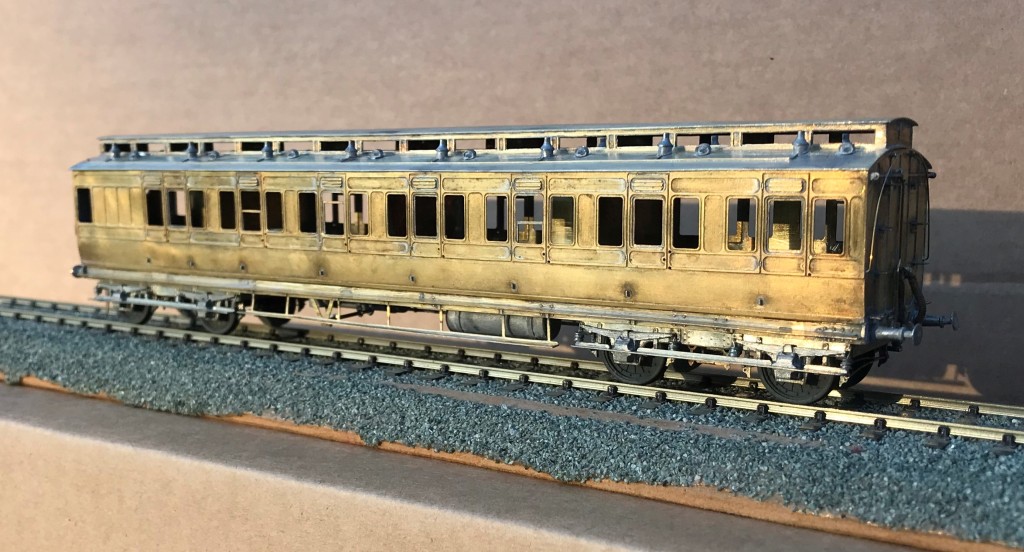
It always amuses me that the driver had to stand and peer down the line through two tiny windows. They lived in different times – could you imagine the snow-flakes tolerating this in the 21st century?
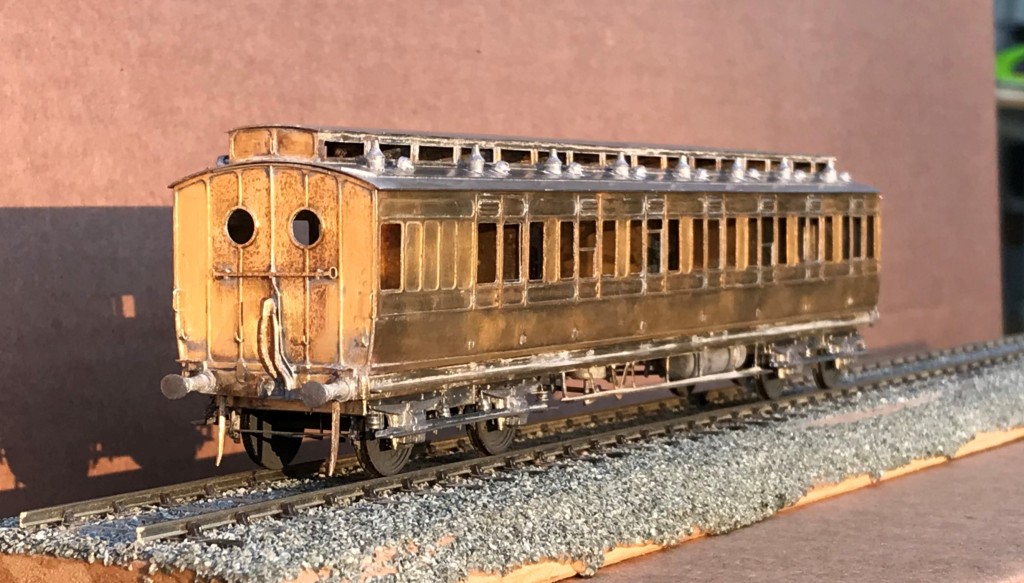
These are rather beautiful coaches, but not for the feint-hearted as there is a lot of time invested in these. I am pleased I do not have to paint it!
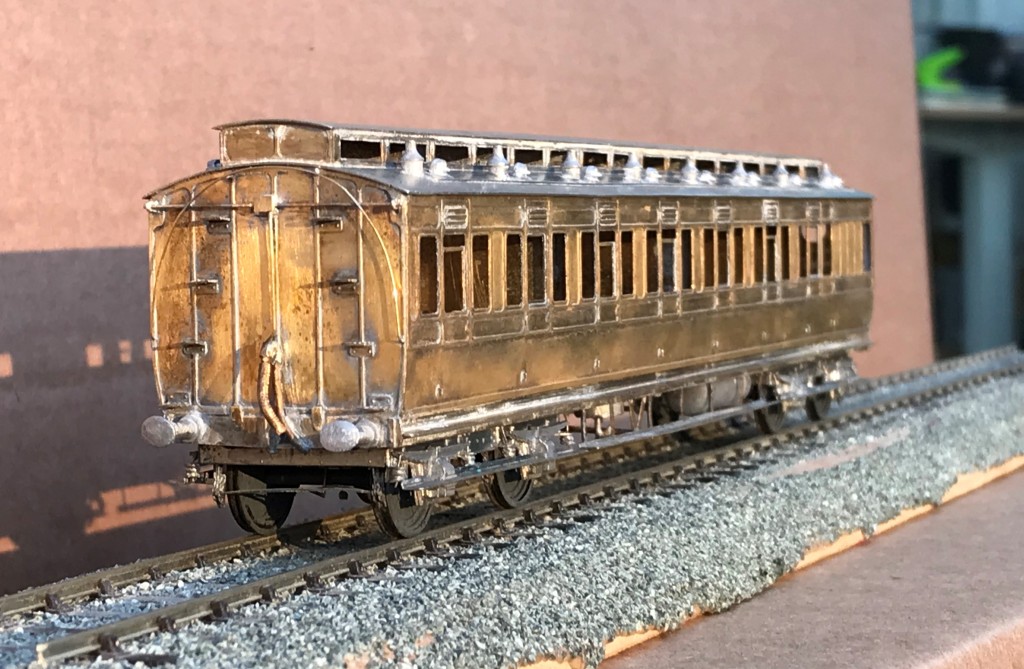
And now a Midland signal…..
Whilst the NER signal from my last post gets itself painted, I turned my attention to the next few signals – in this case these will be Midland lower quadrants.
A lot of the character of a signal is in its finial and if this isn’t right then the model won’t convince. In addition, they are also very vulnerable so need to be durable. Therefore, my conclusion is that white metal finials do not cut the mustard – they are too delicate and too clunky. Thus, in this case I decided to make my own – I came up with this which starts with with some interlocking etches:

And then a bit of brass tube as a collar at the base
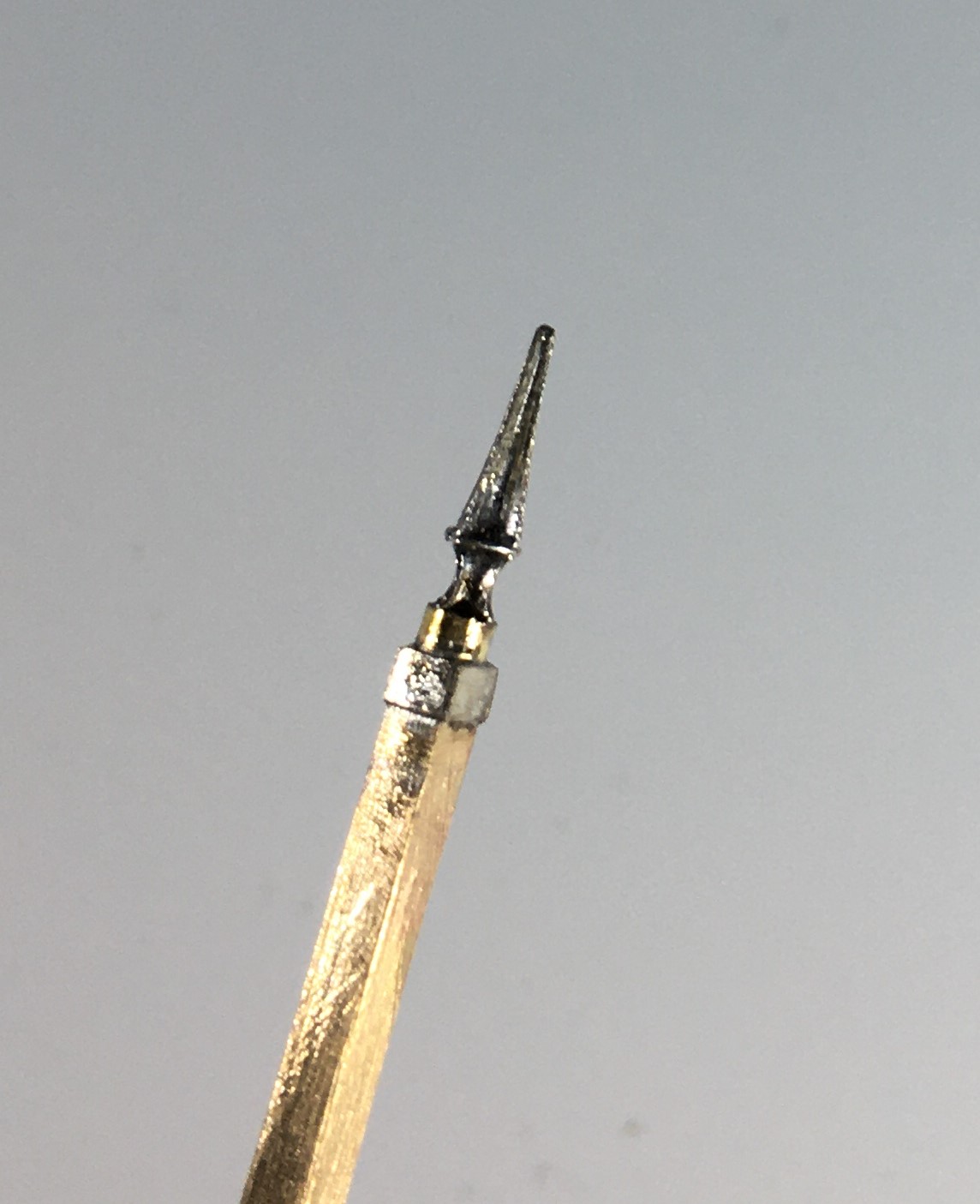
The Midland’s style of signals do have a few idiosyncrasies; one of which is the way that blinders are fixed. Instead of being fixed to the spindle these are secured to the arms and wrap around the lamp. This can be more clearly seen in the photograph below.

The other key change was in the manner in that the arms are secured to the posts. Instead of being pined through the arm and secured at the rear, the Midland used a bracket to the front of the post with a plate that wrapped around to the front of the signal to support the arm to the front. This can be seen in this view of a rather nice gallows signal at Butterley.

The bracket can be seen in this view below and I then created a pin that fitted into the bracket and slotted over the spindle.

I have bought a new light box for taking photographs in. Whilst I am still getting to grips with it, when it works it does produce much improved pictures of models. These almost look like an images of a 3D model on a computer screen. The pliers at the bottom of these views do rather give the game away!

The Midland were a bit odd in their choice of colours for their signals. The posts were “primrose yellow” but this quickly dirtied to something akin to cotswold stone is what the book says, so this does give something a little different. This is my representation of this with a decent dose of smokey dirt – when you look at contemporary photographs many signals were not only dirty but entirely smothered in smoke. I haven’t gone that far yet, but its going to need to be done!


As can be seen, this still needs connecting to the servos and the touching in of the paint on the parts that I fit after the main assembly (the balance lever and the plate that wrapped around the signal arm).
Benfieldside’s Missing Signal
When my friends acquired Benfieldside, it had suffered a bit of damage, notably to its signals – in essence it was this that got me volunteered for their restoration! One signal that puzzled us, however, was the up starter which was missing altogether and we could not unearth any photographs of it. Ultimately, we decided that it should be a two doll signal to also control the adjacent bay (which did have a signal, albeit inoperative) – so I have set to in order to fill this gap.
The line is set in Cumbria and is an imaginary westward extension of the Newcastle & Carlise line. In theory, therefore, it should not have the heavy cast iron brackets that the NER used. However, in reviewing the NERA’s signalling book, it became apparent that there were quite a lot of strays of signal designs, so I had an excuse to build one!

As this particular signal is going to be platform mounted, I did not need to sort out a mount for it and moved straight to the post and bracket, the latter being by MSE which I had in stock.
I then moved on to the prefabrication of a pair of dolls, each with slotted posts. This is made up of solid square section filed to a taper which is then cut and each end then has a tongue filed on it onto which flat plate is soldered either side to create the slots. I used a variety of temperature solders to ease this process but it was not easy – I did have one gum solid which resulted in a need to dismantle it and start again! As alluded to in the previous post, as these are slotted posts I had to depart from my usual practise of fitting the arms after painting as it is not otherwise possible to solder them to the spindle for the arm.

As mentioned in the last post, I came up with a bit of a dodge to successfully (well, in two of three cases!) to solder the arm to the spindle without gumming it up. By extending the ear that forms the point at which the operating rod attaches to the arm forward a bit (see the line below), it provides a point at which the soldering iron can be touched. If you use a slight excess of solder this allows the heat to transmit to the spindle and make the soldered joint.

And this is what you get with a prefabricated doll, ready for the next stage of assembly.

And below of the pair of dolls now inserted to the landing.

Even at this stage, there is still a lot of building to do as there are handrails, the main ladder, steps and ladders to the dolls, the operating mechanism transferring the movement to the dolls all to do. In respect of the latter(I used rocking cams in this case – you can just see the use of some handrail knobs as the bearings in the photos below, the cams will be fitted after painting.

Slightly peculiarly, the NER built their landings in front of the arms whereas all the other signals I have yet built have these in the rear (excepting gantries, which can be either or both!). This view shows this most clearly.

The main ladder is not visible in the views as I have made this detachable because it is much easier to spray paint these (and better, it is not easy to get a thin coat of paint by brush application and it thickens up the fine detail of a ladder too much.

The grey primer is pretty cruel to modelling efforts but on the whole, I am pretty chuffed with this!
One for the Paintshop
I am sure I am not alone in having in mind a list of modelling jobs to do over the Christmas break and to find that the bulk of the list remains uncompleted when it is time to go back to work!!
One item on my list was to finish a North Eastern Railway autocoach that I have had underway for a while and that at least has got itself off the list!

The bulk of this is from a D&S etched kit which I have seriously devalued by opening the box!! I have replaced the fixed bogies with some test build sprung bogies that I have had under development for rather too long now (they are finished, but for the castings which I need now to produce following the demise of Lochgorm Models for at least the time being).

I also replaced the roof with some metal sheet rolled to the curves. This proved a real challenge and took more than one attempt as I found you could not roll the section with the holes for the clerestory already cut as the bend all occurred at this weakened point. I also took the effort to put on the gas lines with fine wire as I think these add so much to a model of this era.

I think they are very attractive coaches but there is a problem with them – they tended to go in pairs so I have another to build! Just not quite yet! Fortunately, the BPT is not down to me, but I think you may find yourself under pressure soon John!!!!

Benfieldside at South Hants – Part 2
Following from last week’s post, here are a selection of further photographs from Benfieldside’s outing at the South Hants show, starting with a few around the platforms.




One of the charms of the layout are its buildings; typically constructed from cereal packets – good old fashioned modelling but very effective as you can see!





There remains a lot of stock to build for the layout and also a fair amount of restoration; the next bit of restoration can be seen in the picture below; a somewhat wonky signal (which will be rebuilt as a two doll to act as a starter signal for both the bay and the main loop). Hopefully, this will be done for ExpoEM, which is the layout’s next outing – see you there?

Many thanks to Dave Brandreth for the photographs in this post, along with some of those in its predecessor.
Benfieldside’s First Outing In a Long Time
Benfieldside has just completed its first outing for what is believed to be 17 years and whilst honesty dictates that we must admit to some glitches; especially first thing, on the whole it went really very well. As I have a fair number of photographs (some with thanks to David Brandreth), I will spread these over a pair of posts to keep people on tenterhooks!

A NER C class (to become a LNER J21) pauses at the starter with a freight train.

The same train in the distance, showing the goods yard with the station throat behind.


Things are quieter at the other end of the station where there is a full brake in the milk bay. The signalman has a commanding view; in part of the slightly droopy signal on the gallows signal!


Because we were so pleased simply to having it running, there was no pretence to running a sensible service (and we were a little short of stock, particularly passenger stock). Thus, the poor coal merchant went without any delivery of coal all day! At least it looks as if he has enough to keep the coal fires of Benfieldside going for a little longer.

Next door, it seems like it might be lunch break at Iliffe & Stokes; builders, joiners and undertakers.
Moor to follow in a few days time…………… If you don’t already do so, you can subscribe to this blog by entering your email address in at the top left of the page. This means you will be sent an email each time I post anything on the blog.
South Hants Model Railway Show
In just over a week from now, I will be down in Portsmouth for the South Hants Model Railway Club’s annual show. Despite being a one day show, I find the show to be a good quality finescale show and the crew down there are very friendly, so it is definitely worth visiting. You can find details of the show here.
I will be assisting in the operation of Benfieldside, which I have illustrated on this blog in the past but it is worth looking at some of the pictures again:

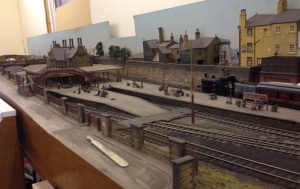

I can assure you it is worth coming to the show to see this alone; and you might even find my latest construction effort – although probably still shiny like this. This is a D&S Models NER auto-carriage and really needs a sister to work with it but that will have to wait!

\
Stop by and say hello if you do visit.
Benfieldside and her Signals
This weekend I braved the traffic heading to the Festival of Speed in order to complete the building of a replacement fiddle yard for Portchullin (of which more another day) with Tim & Julian. Once complete, I stopped by to see how Benfieldside has been getting on and in particular what my signals looked like in thier proper home.
First up the gallows signal (which has dropped a bit low on its swing).


And then the twin and three doll brackets.


All the above signals were restorations (although not so much was retain on the two doll); the single posts below were made afresh.


And having inspected the signals it was time for a play with the layout and take some pictures to share with you. So here we go:







The guys are still building up sufficent stock for it so it won’t be out on the road for a year yet but I understand that the layout should be at the South Hants MRC show in November 2017. So hopefully I will see you there?
Missenden Adventure – Part 1
Most years I attend the Missenden Railway Modellers Spring Weekend and have just returned from this year’s. The weekends have some 70 or so railway modellers congregating for a residential retreat to both learn some new skills, enjoy the company and get some quality modelling time in. The participants split between different groups depending what they wish to do; trackwork, weathering, painting/lining, DCC sound control, backscenes and, in my case, loco building.
In my case I started a new loco (of course…..), but not a Highland one. This is a North Eastern 2-4-0 “Tennant” produced by Arthur Kimber. I am building this for Tim & Julian for them to use on their layout, Benfieldside. Thus it is going to be in EM, but I am going to put in clearances sufficent to convert it on to P4 if this ever takes my fancy, and it will be in NER green – so it should look rather fine. Indeed, it should look a bit like this (:only hopefully at a higher resolution!):

Slightly annoyingly, the kit was conceived to be built to P4, so instead of converting OO/EM kits to P4, I am converting a P4 kit to EM!! However, at least it is all the same skills and cutting bits off to make them narrower, is easier than splicing them in! One small departure has been to use some Markits wheels to act as some test track dummies for the build. The idea is that they are capable of being taken on and off without damage, are not steel (so are not going to corrode) and also that they automatically quarter themselves. This is they in the largely completed chassis (which is a rolling chassis, even if I have not yet fitted a motor). Also of note is the valve gear (dummy, life is not long enogh to making working inside gear – and nor am I a good enough modeller!). At present the slide bars and pistons are not yet fitted.
Unlike Highland locos, the running plate and valancing has high swept up sections and really nice flowing curves. This took quite a lot of care to form and I found it necessary to clamp both the front and rear in place initially, after the shape had been bent. Once, however, one end was soldered in place, the second end need to be released so that the thermal expansion did not distort the running plate.
There are more of these sweeping curves to the cab, which also give rise to some tense moments as it is formed. So long as the folds are made at the right locations and around a former the curves formed quite well. When this is added to the running plate, it starts to look like a locomotive.
The boiler comes pre-rolled, with all of the cuts for the wheels and holes already formed. The smokebox is a seperate part that is secured onto the boiler by a bolt and nut. This is quite effective and may well be something that I mimic in the future. The boiler does not come with boiler bands, so I will have some fun putting these on. It also appears to be about 1/2mm too long, so some cutting and filing is going to occur.
This is what it looks like with the boiler plonked on it (as I said, it is a bit too long so is not sitting down properly – however, it does look good and very different from anything the Highland had!
Sorry if it looks a bit silly on its reduced size wheels! This will get explained and corrected nearer the end of the build.











